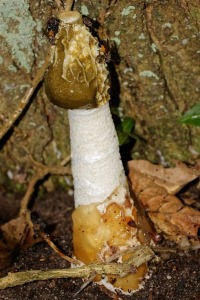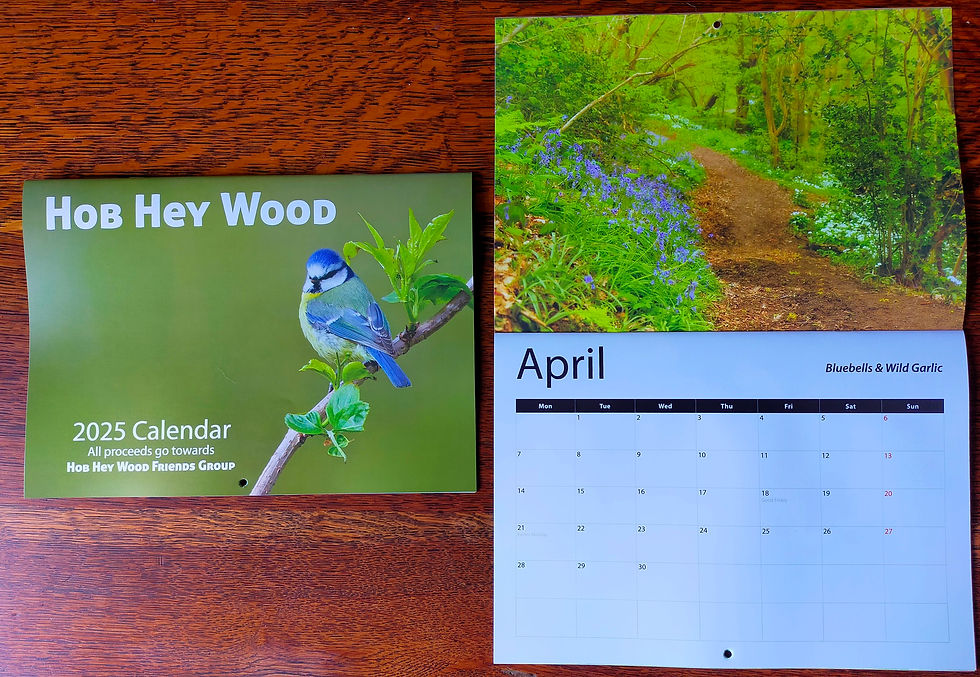An Autumn Walk Through Hob Hey Wood
- Mark O'Sullivan

- Aug 30, 2020
- 6 min read
Updated: Nov 4, 2022

Join us for a walk in Hob Hey Wood enjoying all of the sights the autumn season has to offer. The wood can be very muddy after rain so make sure you're wearing good walking boots or wellies.

Limited parking is available on Townfield Lane and Langdale Way (shown as ‘P’ on the map). At a fast pace, this walk could be covered in about 45 minutes, but allow 1.5 hours to take in all of the beautiful sights of the season.
Start at the top of Langdale Way (marked ‘start’ on the map), turn left onto a track and follow it for 100 metres. Go through the gap in the hedge and follow the field edge for another 200 metres. Go through the gap in the hedge and cross the field (the well-walked path across the field should be obvious), then go through the gap in the hedge and turn right. In autumn, this field can host a huge flock of finches: chaffinches, greenfinches, and possibly even the rarer brambling.
Follow the field edge down to the bottom passing a small pond, go through a gap in the hedge down onto a path. Turn right and follow the path for 100 metres. You will come to a large fallen metal gate.

This is the entrance to the ‘new wood’ (Point ‘A’). Originally a field, nineteen years ago a local businessman bought it and planted 2,000 trees of eleven different native species. He created paths for the public to use. What a wonderful thing to do. This is a good area to spot bullfinches, one of our most colourful birds. Listen out for their faint whistling calls and watch for flashes of red and black plumage.

The new wood has a large number of birch trees which are the favoured haunt of many species of fungi. You can find deceivers, birch boletes, and many more. There's even one, called a witches hat! Another mushroom has a lilac colour and smells of coconut!
Follow the large path through the wood until it comes out at a clearing next to a bridge over the stream (Point ‘B’). This is the entrance to Hob Hey Wood, Frodsham’s ancient woodland. To be classified like this a wood must be at least 400 years old. Hob Hey is probably much older as it was part of the ancient forests of Mara and Mondrem that covered much of medieval Cheshire. Now there are only a few remnants left such as Hob Hey.
Ancient woodland is Britain’s most biodiverse habitat, home to many thousands of species of plant, animal and insect. It is a fragile habitat, and once an ancient woodland is gone it cannot be replaced. Hob Hey is therefore extremely important to the people of Frodsham and the wildlife that calls it home.
Go over the bridge and you’ll see a small clearing to the right. There are a couple of ancient, partly hollow ash trees here, bent into weird shapes over the years. Trees like this are home to bats. We have at least seven species of bat living in the wood including the very rare Nathusius’ pipistrelle. An evening visit with a bat detector in early autumn (before the bats hibernate) will reveal just how many bats rely on this ancient landscape.

The area to the left of the bridge has been planted with field maple. This is our native maple tree (unlike the invasive sycamore) and provides delightful colour in autumn, with the leaves turning a vivid yellow. Stand under one of the trees on a sunny day and look up, the sunlight filtering through the foliage lights up the yellow leaves giving them a beautiful golden halo.
This area of the wood is full of alder trees which produce tiny cones. These can attract small finches like lesser redpoll and siskin. Look for them high up in the trees. As the leaves die off, you’ll almost certainly see great spotted woodpecker, nuthatch and treecreepers, Hob Hey’s woodland specialists, hopping around looking for prey.
Follow the path away from the bridge (Point ‘C’). There are lots of rotting logs in this area that are ideal for fungi to grow on. Hob Hey contains a wide variety of fungi in all shapes, sizes and colours. Some are incredibly colourful; bright yellow, startlingly white, or vivid red although being small, some can be hard to spot.

If you have an eye for detail, look out for the frosty bonnet. This tiny mushroom is ghostly white and looks like it’s been frosted with icing sugar; a beautiful, delicate little thing.
There are many other fungi to spot, with weird appearances and names: conecaps, waxcaps, deceivers, boletes, stagshorn, candlesnuff; the variety really is endless. Hob Hey is a wonderful spot for fungi so keep your eyes peeled as you continue the walk.

Soon you will arrive at the main bridge where the bridle path bisects the wood (Point ‘D’). Hob Hey’s stream forms an artificial waterfall, here. Normally, it is a trickle but after autumn storms it can transform into a raging torrent which can roar so loudly that you need to raise your voice to be heard. Steps down to the water next to the picnic bench gives a wonderful view if the stream is full.
The stream here often attracts a beautiful little bird called the grey wagtail. More yellow than grey, it wanders along the side of the stream looking for insects, wagging its tail furiously. These birds can be quite confiding allowing a close-up look (and photo).

As you walk here, you may notice a smell a bit like rotting meat. This may be a dead animal but it’s more likely to be a stinkhorn. This fungus has a novel way to disperse its spores. Its cap exudes a foul smell that attracts flies. They land on the cap, the spores adhere to their feet, and are spread when the fly moves to another area. This fungus looks and smells like nothing else in the wood!
Cross over the bridle path (marked with a dotted line on the map) and into the northern part of the wood. There are two paths here, take the left one for a long loop of the northern wood. Look out for a spectacular plant here, ‘lords and ladies’. This has many names e.g. ‘cows and bulls’, ‘Adam and Eve’, most referring to the plants likeness to male and female genitalia! In autumn it produces spectacular red berries which are poisonous and actually the most common reason for hospital visits due to poisoning (so look, don’t touch)!
At the end of the path is a horizontal horse chestnut tree (Point ‘E’). This has not fallen; it’s grown this way and produces many conkers in the autumn. Although there are no benches here (yet!) you can lean against the chestnut. And it’s worth doing so as this is one of the most isolated parts of the wood. Deep in a valley, surrounded by trees, the only sounds you’ll probably hear are birdsong, the wind in the trees, and the babbling little brook. Close your eyes and listen, it’s a lovely way to spend a few minutes. Spending time in nature this way is known as ‘Forest Bathing’. This has been shown to have proven health benefits such as reduced blood pressure, boosted immune system and improved sleep! Amazing.

This area has a lot of elder trees on which live a most unusual fungus; the jelly ear. This description is perfect as this fungus looks very ear-like and feels just like jelly. This is another edible fungus but it does not appeal to me at all!
Go over the bridge and up the steps to another path which leads back to the main bridge. About halfway there, there’s another set of steps and a huge, gnarled oak tree that dominates the skyline (Point ‘F’). This oak is over 200 years old. When the Battle of Waterloo was being fought, this tree was a sapling. Imagine all that’s happened in the past two centuries; this tree has endured it all, towering above humans and their frantic activities, and is still here today.

Next to the ancient oak is a large beech tree. Unremarkable in summer, this is transformed in autumn to a living waterfall of colour. The cascading branches are full of leaves which turn a metallic bronze in autumn. Standing next to the tree you can admire this feast for the eyes which lasts for only a couple of weeks.
Carry on this path and you pass an area on the left with lots of rotting wood. Look here for more of Hob Hey’s fabulous fungi. Here, you’ll also see results of some of the work carried out by Hob Hey Wood Friends Group. We’ve planted over 1,400 trees in the past two years. You’ll see clear plastic pipes covering the tiny trees which are currently only about a foot tall. Hopefully, these oak, rowan, birch, hazel and others will grow to be valuable additions to our ancient woodland.
You will soon be back at the main bridge. Take the wooden gate opposite into the orchard (Point ‘G’). This is one of Frodsham’s community orchards and contains trees, the fruit of which is for people to pick and enjoy (in late summer). In autumn, the fruit will be gone with the trees only giving only the faintest hint of what’s to come with next year’s harvest.
The orchard is also where I have taken some nice trailcam footage of the foxes that live in the wood. Hob Hey supports a healthy population and a daytime encounter is always possible. Put out some bait and a trailcam, however, and you're almost guaranteed that 'Mr Fox' will happen along. Follow the orchard round, and take the stone steps down to the bridle path and turn right (Point ‘H’). Follow the bridle path up to Townfield Lane and turn right to take you back to your car.




Comments